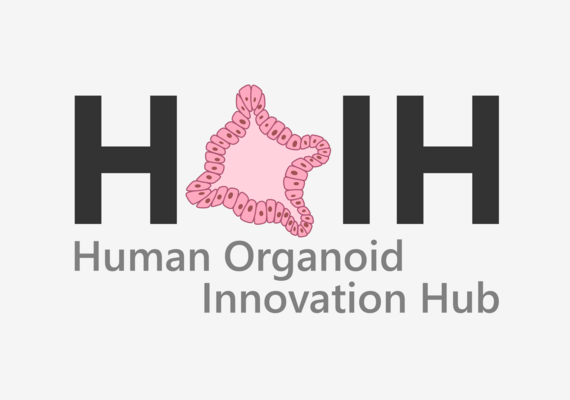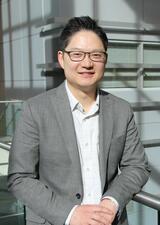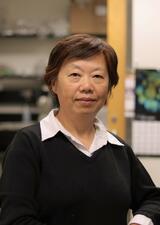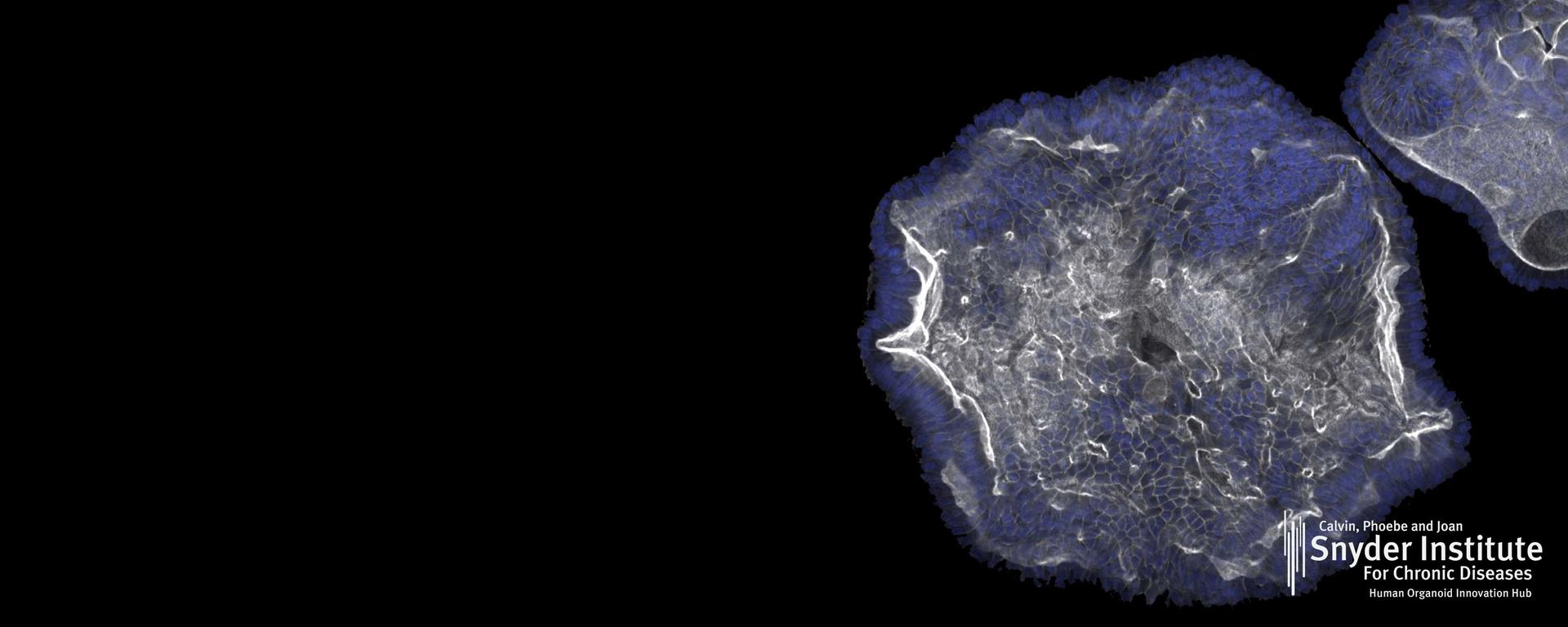The Human Organoid Innovation Hub (HOIH) is a Snyder Institute core facility with a vision of advancing cutting-edge research utilizing organoid systems. Our mission is to leverage patient tissue and induced pluripotent stem cell technology to drive precision medicine.
The HOIH provides all the necessary training and resources to grow human and mouse 3D and 2D organoid systems and provides expertise in designing and executing experiments using this model system.
Beyond this, the HOIH constantly strives to test and develop new organoid protocols and provide the latest organoid innovation and technology to serve our research community. This facility will support each user by providing organoid samples and collaborating on research endeavours.
The HOIH Commitment
Biopsy-derived Organoid Models
- Human 3D organoids and 2D monolayers - derived from small intestine and colon of healthy donors and inflammatory bowel disease (IBD) patients (Crohn’s disease and ulcerative colitis)
- Organoid co-culture system - Integration of organoids with immune cells, mesenchymal stroma cells (MSCs), etc., to model complex cellular interaction
- Air-liquid-interface (ALI) intestinal monolayers (in development)
- Apical-out intestinal organoids
- Gut-on-a-Chip (in development)
- Primary 3D Human nasal organoids/ALI (in development)
- Mouse small intestine and colon 3D organoids and monolayers (training only)
Services
Consultation Services
- Organoid project/experiment design/troubleshooting
- Protocol sharing
- Letter of support for grant applications
- iPSC reprogramming and differentiation strategy consultation
Organoid Culture Services
- Healthy and diseased human intestinal 3D organoids and 2D monolayers
- Generation of mouse organoids (special request only)
- Human and mouse media
- Basal Membrane Extract (e.g. Matrigel, Cultrex)
- Media Supplements
Experimental Services
- Pilot/feasibility/revision experiments
iPSC-derived Cells/Organoid Models
- Reprogramming of peripheral blood mononuclear cells (PBMCs) from healthy individuals or patients into induced pluripotent stem cells (iPSC)
- Generation of iPSC-derived macrophages
- Generation of iPSC-derived kidney organoids
- Generation of iPSC-derived intestinal and colonic organoids
- Generation of iPSC-derived bone marrow organoids (in development)
Training
- Human and mouse organoid isolation
- Human and mouse organoid maintenance (feeding, passaging, and freezing)
- Human and mouse monolayer seeding
- Immunofluorescence preparation and imaging (in collaboration with the Live Cell Imaging)
- RNA/DNA/protein isolation for downstream applications
- iPSC culture maintenance (feeding, passaging, and freezing)
We would like to thank our funding sources that make this facility possible, including the Cumming Medical Research Fund and the office of the Vice President Research, University of Calgary. We would also like to thank the health care professionals and patients who make this work possible.

Get Started with the HOIH
Contact us today!
hoih@ucalgary.ca
Lab: HSC 2870/2830/1612
Office: HSC 2824/1685
HOIH Supported Publications
- Chung H, Rahmani W, Sinha S, Imanzadeh A, Pun A, Arora R, Jaffer A, Biernaskie J, Chun J. Nephron progenitor fate is modulated by angiotensin type 1 receptor signaling in human kidney organoids. Stem Cells. 2025 Mar 20. https://doi.org/10.1093/stmcls/sxaf012
- Gutierrez MW, van Tilburg Bernardes E, Ren E, Kalbfleisch KN, Day M, Lameu EL, Glatthardt T, Mercer EM, Sharma S, Zhang H, Al-Azawy A, Chleilat F, Hirota SA, Reimer RA, Arrieta MC. Early-life gut mycobiome core species modulate metabolic health in mice. Nat Communications. 2025 Feb 8;16,1467. https://doi.org/10.1038/s41467-025-56743-8
- Shin J, Chung H, Kumar H, Meadows K, Park S, Chun J, Kim K. 3D bioprinting of human iPSC-Derived kidney organoids using a low-cost, high-throughput customizable 3D bioprinting system. Bioprinting. 2024 Mar 8;38:e00337. https://doi.org/10.1016/j.bprint.2024.e00337
- Chojnacki AK, Krishnan SN, Jijon H, Shutt TE, Colarusso P, McKay DM. Tissue imaging reveals disruption of epithelial mitochondrial networks and loss of mitochondria-associated cytochrome-C in inflamed human and murine colon. Mitochondrion. 2023 Jan;68:44-59. https://doi.org/10.1016/j.mito.2022.10.004
- Dvořák Z, Kopp F, Costello CM, Kemp JS, Li H, Vrzalová A, Štěpánková M, Bartoňková I, Jiskrová E, Poulíková K, Vyhlídalová B. Targeting the pregnane X receptor using microbial metabolite mimicry. EMBO Molecular Medicine. 2020 Mar 10;12(4):e11621. https://doi.org/10.15252/emmm.201911621
- Fernando EH, Dicay M, Stahl M, Gordon MH, Vegso A, Baggio C, Alston L, Lopes F, Baker K, Hirota S, McKay DM. A simple, cost-effective method for generating murine colonic 3D enteroids and 2D monolayers for studies of primary epithelial cell function. American Journal of Physiology-Gastrointestinal and Liver Physiology. 2017 Nov 1;313(5):G467-75. https://doi.org/10.1152/ajpgi.00152.2017
Co-Directors

Dr. Simon Hirota, PhD
Professor & Associate Dean Research (Infrastructure)
Dept. of Physiology & Pharmacology
Dept. of Microbiology, Immunology & Infectious Diseases
shirota@ucalgary.ca

Dr. Justin Chun, MD, PhD, FRCPC
Associate Professor/Clinician Scientist
Dept. of Medicine
Cumming School of Medicine and Alberta Health Services
chuj@ucalgary.ca
HOIH Tissue Organoids Core Personnel

Dr. Hong Zhang, PhD
Research Methods Associate
zhanh@ucalgary.ca
Elizabeth Hughes, MSc
Research Technician
chughes@ucalgary.ca
HOIH iPSC Organoids Core Personnel
Dr. Hyun Jae Chung, PhD
Senior Stem Cell Scientist
hjchun@ucalgary.ca
Marin Flanagan, BSc
Research Technician
marin.flanagan1@ucalgary.ca
HOIH-Affiliated Staff (Canadian National Organoid Network)

Maria Arzamendi, MSc
Research Associate
maria.arzamendi@ucalgary.ca

Joshua Lee, BHSc
Research Coordinator
joshua.lee1@ucalgary.ca


